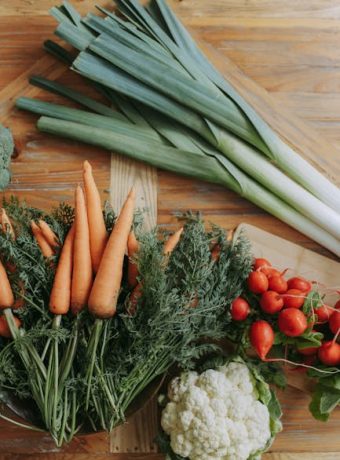Spring Vegetables: Fresh Choices for a Green Diet
As the chill of winter fades and the days grow longer, nature awakens with a burst of vibrant colors and fresh, nutrient-rich vegetables. Embracing spring vegetables is not only a delightful culinary experience but also a fantastic way to boost your health and support sustainable agriculture. This blog post will guide you through the best spring vegetables to include in your diet, their nutritional benefits, and some delicious ways to prepare them.
Why Choose Spring Vegetables?
Spring vegetables are seasonal delights that offer a myriad of benefits. They are fresher, more flavorful, and packed with essential nutrients. Here are a few reasons why spring vegetables should be a staple in your green diet:
- Freshness: Spring vegetables are harvested at their peak, ensuring maximum flavor and nutritional value.
- Eco-Friendly: Eating seasonally reduces the carbon footprint associated with transportation and storage.
- Health Benefits: These vegetables are rich in vitamins, minerals, and antioxidants, contributing to overall well-being.
Top Spring Vegetables to Include in Your Diet
Here are some of the best spring vegetables to enjoy this season:
Asparagus
Asparagus is a versatile and nutrient-dense vegetable that can be grilled, roasted, or steamed. It is rich in vitamins A, C, E, and K, as well as folate and fiber. Asparagus also contains antioxidants, which help combat free radicals and reduce inflammation.
Tip: Try roasting asparagus with olive oil, garlic, and a sprinkle of parmesan cheese for a delicious side dish.
Peas
Peas, including sugar snap peas and garden peas, are a sweet and crunchy addition to any meal. They are high in protein, fiber, and essential vitamins like A, C, and K. Peas also contain phytonutrients that support healthy vision and immune function.
Tip: Add fresh peas to salads, stir-fries, or simply steam them with a bit of mint for a refreshing taste.
Radishes
Radishes are known for their peppery flavor and crunchy texture. They are low in calories but high in vitamins C and B6, potassium, and folate. Radishes also have detoxifying properties and can aid in digestion.
Tip: Slice radishes thinly and add them to salads or use them as a crunchy topping for tacos.
Spinach
Spinach is a leafy green powerhouse packed with iron, calcium, magnesium, and vitamins A, C, and K. It supports bone health, boosts the immune system, and promotes healthy skin.
Tip: Incorporate spinach into smoothies, sauté it with garlic for a simple side dish, or use it as a base for fresh salads.
Fava Beans
Fava beans, also known as broad beans, are a springtime favorite. They are high in protein, fiber, and essential nutrients like folate, iron, and manganese. Fava beans also contain L-dopa, which has been linked to improved brain function and mood.
Tip: Blanch fava beans and toss them with lemon juice, olive oil, and fresh herbs for a light and nutritious salad.
Cooking Tips and Recipe Ideas
Incorporating spring vegetables into your diet can be both enjoyable and easy. Here are some cooking tips and recipe ideas to help you get started:
Grilled Asparagus with Lemon and Parmesan
Grilling asparagus brings out its natural sweetness and adds a smoky flavor. Toss asparagus spears with olive oil, salt, and pepper, and grill until tender. Finish with a squeeze of lemon juice and a sprinkle of parmesan cheese.
Spring Pea and Mint Salad
This refreshing salad combines sweet peas, fresh mint, and a simple lemon vinaigrette. Blanch peas until tender, then mix with chopped mint, lemon juice, olive oil, salt, and pepper. Serve chilled.
Radish and Avocado Toast
For a quick and nutritious snack, top whole-grain toast with mashed avocado, sliced radishes, a drizzle of olive oil, and a pinch of sea salt.
Spinach and Strawberry Salad
This vibrant salad pairs fresh spinach with sweet strawberries, toasted almonds, and a balsamic vinaigrette. Toss spinach and sliced strawberries with a dressing made from balsamic vinegar, olive oil, honey, and Dijon mustard.
Sautéed Fava Beans with Garlic and Herbs
Sauté blanched fava beans with olive oil, minced garlic, and fresh herbs like parsley or dill. Season with salt and pepper to taste.
The Environmental Impact of Eating Seasonal Vegetables
Choosing to eat seasonal vegetables like those available in spring has a positive impact on the environment. Here are some key benefits:
- Reduced Carbon Footprint: Eating locally sourced, seasonal vegetables reduces the need for long-distance transportation, lowering greenhouse gas emissions.
- Less Energy Usage: Seasonal produce requires less energy for storage and refrigeration compared to out-of-season imports.
- Support for Local Farmers: Purchasing seasonal vegetables from local farmers supports the local economy and promotes sustainable farming practices.
Conclusion
Spring is a wonderful time to rejuvenate your diet with fresh, nutrient-packed vegetables. From asparagus and peas to radishes, spinach, and fava beans, there are countless delicious and healthy options to explore. By incorporating these seasonal vegetables into your meals, you not only enhance your nutrition but also support sustainable agriculture and reduce your environmental footprint. So, head to your local farmer’s market or grocery store and start enjoying the bounty of spring vegetables today!
Remember, eating a variety of vegetables is key to a balanced diet, so don’t hesitate to experiment with new recipes and cooking methods. Your body and the planet will thank you.



